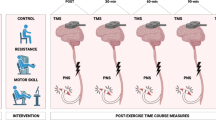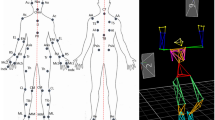Summary
The aim of this study has been to identify, in humans, the braking process underlying voluntary forearm movements performed at various velocities and amplitudes and against different inertial loads. The procedure used to estimate the parameters of the braking process involved kinematic analysis of the movement and measurement of alpha-motoneural input to flexor and extensor muscles by recording electromyographic (EMG) activity. We have shown that when the agonist force does not exceed the passive viscoelastic tension developed by the extensor and flexor muscles, the movement can be braked by the viscoelastic forces alone. In contrast, above this force threshold, it was found that the motor output in agonist and antagonist muscles consists of well defined bursts of EMG activity, first in agonist then in antagonist muscles. The timing of these two bursts (duration of the agonist activity and onset of the antagonist activity) are clearly correlated with the value of the peak velocity. For the same peak velocity, the addition of inertial loads increases the excitation level of both agonist and antagonist muscles but does not change the timing of the EMG bursts. The discussion of these results focuses on the concept of “unit of movement” organized to reduce the large number of possible patterns of activation of the muscles acting on the same joint.
Similar content being viewed by others
References
Bernstein, N.: The coordination and regulation of movements. New York: Pergamon Press 1967
Bizzi, E., Polit, A., Morasso, P.: Mechanisms underlying achievement of final head position. J. Neurophysiol. 39, 435–444 (1976)
Bouisset, S., Lestienne, F.: The organisation of a simple voluntary movement, as analysed from its kinematic properties. Brain Res. 71, 451–457 (1974)
Bouisset, S., Lestienne, F., Maton, B.: The stability of synergy in agonists during the execution of a simple voluntary movement. Electroenceph. Clin. Neurophysiol. 42, 543–551 (1977)
Brooks, V.B., Stoney, S.D.: Motor mechanisms: the role of the pyramidal system in motor control. Ann. Rev. Physiol. 33, 337–392 (1971)
Engberg, I., Lundberg, A.: An electromyographic analysis of stepping in the cat. Experientia 18, 174–176(1962)
Evarts, E.V.: Representation of movements and muscles by pyramidal tract neurons of the precentral motor cortex. In: Yahr. M.D. and D.P. Purpura (eds.), Neurophysiological basis of normal and abnormal motor activities, pp. 215–251. New York: Raven Press 1967
Fiori-Savary, N., Lestienne, F.: Influence de l'inertie sur le couplage agoniste-antagoniste au cours de mouvements volontaires de flexion ou d'extension de l'avant-bras. J. Physiol. (Paris) 72, 22A (1976)
Freund, H.J., Büdingen, H.J.: The relationship between speed and amplitude of the fastest voluntary contractions of human arm muscles. Exp. Brain Res. 31, 1–12 (1978)
Gelfand, I.M., Gurfinkel, V.S., Tsetlin, M.L., Shik, M.L.: Some problems in the analysis of movements. In: I.M. Gelfand (ed.), Models of the structural-functional organization of certain biological systems, Vol. 1, pp. 329–345. Cambridge: M.I.T. Press 1971
Ghez, C., Vicario, D.: The control of rapid limb movement in the cat. II. Scaling of isometric force adjustments. Exp. Brain Res. (submitted) (1979)
Gurfinkel, V.S., Lipchits, M.J., Popov, K.E.: Is the stretch reflex the main mechanism in the system of regulation of the vertical posture in man? Biophysics 19, 744–748 (1974)
Hallett, M., Adam, J., Marsden, C.D.: Ballistic movements in man. Int. symp. on human reflexes and motor disorders, Brussels, pp. 91–92 (1976)
Hallett, M., Marsden, C. D.: Ballistic flexion movements of the human thumb (in prep.) (1979)
Lestienne, F.: Motor activity during intentional arrest of passive movements. III. Int. symp. on motor control, Varna, in resume of communications, pp. 43–44 (1976)
Lestienne, F., Bouisset, S.: Role played by the antagonist in the control of voluntary movement. 4th Int. symp. on external control of human extremities, Dubrovnik, 1972. In: Gavrilovic and Wilson (eds.), Advances in external control of human extremities, Vol. 1, pp. 12–21. Belgrade: Etan Press 1974
Lestienne, F., Pertuzon, E.: Determination of the visco-elastic properties of human muscle in situ. Eur. J. Appl. Physiol. 32, 159–170 (1974)
Marsden, C.D., Merton, P.A., Morton, H.B.: Servo action in the human thumb. J. Physiol. (Lond.) 257, 1–44 (1976)
Nashner, L.M.: Fixed patterns of rapid postural responses among leg muscles during stance. Exp. Brain Res. 30, 13–24 (1977)
Partridge, L.D.: Intrinsic feedback factors producing inertial compensation in muscle. Biophys. J. 7, 853–863 (1967)
Polit, A., Bizzi, E.: Characteristics of the motor programs underlying arm movements in monkeys. J. Neurophysiol. 42, 183–194 (1979)
Shik, M.L., Orlovsky, G.N.: Neurophysiology of locomotor automatism. Physiol. Rev. 56, 465–501 (1976)
Terzuolo, C.A., Soechting, J.F., Viviani, P.: Studies on the control of some simple motor tasks. I. Relations between parameters of movement and EMG activities. Brain Res. 58, 212–216 (1973)
Wachholder, K.: Willkürliche Haltung und Bewegung, insbesondere im Lichte elektrophysiologischer Untersuchungen. Ergebn. Physiol. 26, 568–775 (1928)
Watt, D.E.D.: Passive mechanical factors governing head and neck movements at the onset of sudden falls in the cat. Am. J. Phys. Med. 55, 291–300 (1976)
Author information
Authors and Affiliations
Additional information
This research was supported by a grant from the DGRST (génie biologique) and IRIA (Spartacus Program)
Rights and permissions
About this article
Cite this article
Lestienne, F. Effects of inertial load and velocity on the braking process of voluntary limb movements. Exp Brain Res 35, 407–418 (1979). https://doi.org/10.1007/BF00236760
Received:
Issue Date:
DOI: https://doi.org/10.1007/BF00236760




